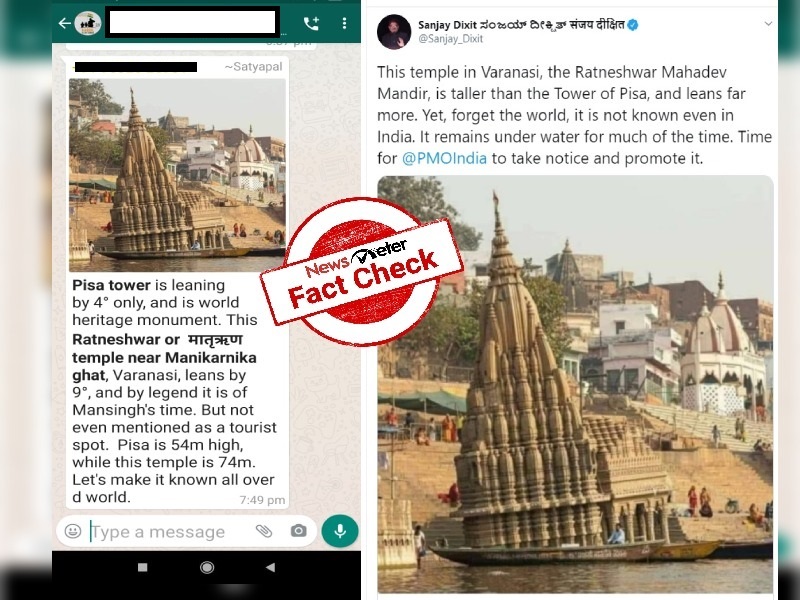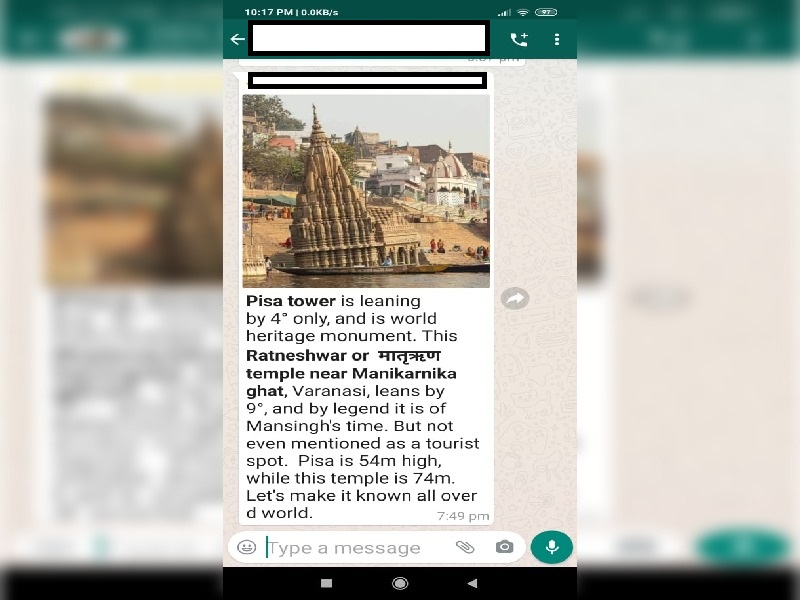Picture showing Ratneshwar temple in Varanasi leaning by 9 degree is TRUE
By Satya Priya BN
Hyderabad: A picture of an ancient temple is being shared on the social media with a claim that "Pisa tower is leaning by 4 degree only, and is world heritage monument. This Ratneshwar temple near Manikarnika Ghat, Varanasi, leans by 9 degree, and by legend it is of Mansingh's time. But not even mentioned as a tourist spot. Pisa is 54m high while the temple is 74m. Let's make it known all over the world"
A user shared it on Twitter stating, "This temple in Varanasi, the Ratneshwar Mahadev Mandir, is taller than the Tower of Pisa, and leans far more. Yet, forget the world, it is not known even in India. It remains under water for much of the time. Time for @PMOIndia to take notice and promote it.
This message is going viral on WhatsApp too.

Fact Check:
The claim that Ratneswar temple leans more than Tower of Pisa is TRUE.
When searched for the image using reverse image search, we found several interesting facts about the temple situated in Varanasi. This temple is situated at Manikarnika Ghat. The inner sanctum of this temple remains submerged in water throughout the year except for a few summer months. It is situated on the bank of Ganga and there are several interesting stories associated with the submersion of this temple.
The temple was built extremely close to the Ganges river and has developed a nine-degree slant. By contrast, the Leaning Tower of Pisa in Italy tilts just four degrees.
No one knows, exactly, why the temple has developed such a severe lean. Like so many buildings and monuments in India, legend and history do not match up when it comes to Ratneshwar Mahadev temple. The lean could be the result of a structural problem or because it was built on silt or because of a curse.
Also called the Kashi Karvat (Kashi is the ancient name for Varanasi and karvat means leaning in Hindi), the temple was probably built in the mid-19th century, either by the Queen of Gwalior or the Amethi royal family. Photos of the temple from the 1860s show that it was not leaning at that time.
According to one of the beliefs, the temple ghat collapsed and leaned backwards after not being able to withstand its weight. The temple is believed to have stood straight before the 1860s. It eventually leaned back owing to reasons unclear. The exact cause has not been identified yet. There are a couple of more stories attached to this architectural phenomenon.
According to Kevin Standage, an Indian Travel Photography Blog, the temple is famous for having a lean of around nine degrees, a far more severe deviation from vertical compared to the likes of the Leaning Tower of Pisa which currently has a four-degree lean.
Though we found the elevation of the temple to be 73.14 m in Wikipedia, no other proper documentation has been found in support of this information about the temple's elevation.
Leaning Tower of Pisa, Italian Torre Pendente di Pisa, medieval structure in Pisa, Italy, is famous for the settling of its foundations, which caused it to lean 5.5 degrees (about 15 feet [4.5 metres]) from the perpendicular in the late 20th century.
Extensive work was subsequently done to straighten the tower and its lean was ultimately reduced to less than 4.0 degrees.
In terms of angles, the tower now leans at 3.99 degrees. Considering the weight and height of the tower, physicists have said the maximum angle would be 5.44 degrees before the tower falls.
Tower of Pisa leans about 4 degrees, whereas Ratneswar Temple leans over 9 degrees.
According to the statistics, the claim that Ratneswar Temple leans more than Tower of Pisa is TRUE.
[Updated: August 3, 2020]